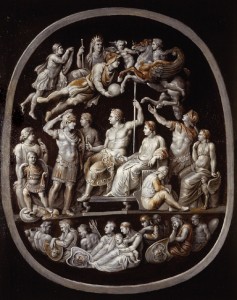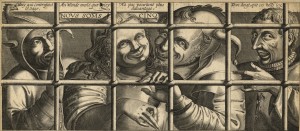I have just started cataloguing Douce’s prints of fools -the engraving below belongs to the popular type depicting a group of foolish figures that numbers one fewer than the title, so that the viewer makes up the total:
On the mount, Douce wrote that it was given to him at Paris ‘by the worthy Abbé Tersan’, probably in the course of a trip that took place between August and September 1817. Charles-Philippe Campion de Tersan (1736-1819) was an antiquary born in Marseille and a renowned collector: by 1818, his was regarded as ‘the most singular and most copious’ of ‘all the collections of antiquities called Roman and Greek’ that could be seen in Paris (Stephen Weston, La Scava, London, 1818, p. iv).
Tersan collected antiquities, maps, prints, Indian and Chinese curiosities, and medals, most of which were sold in 1819. This depiction of the “Gemma Tiberiana” by Rubens, which came to the Ashmolean in 1989, was among them:

Sir Peter Paul Rubens, The ‘Apotheosis of Germanicus’: copy after an antique Cameo ( The ‘Gemma Tiberiana’), 1626, oil on canvas (Ashmolean Museum, Oxford)
Many of Tersan’s prints, however, ended up in the Bibliothèque Nationale. Douce might have been introduced to him by either Charles Townley (1737-1805) or Richard Payne Knight (1751-1824) -the latter bought some of Tersan’s Italian drawings in 1791. The entry on the Abbé that appeared in the Biographie universelle (1826) explained how he ‘compared antiquities from different peoples and he used the objects in his collections to clarify certain passages in the works of ancient authors and of modern travellers’ -and this is, of course, very similar to what Douce did with his own prints.

